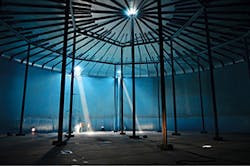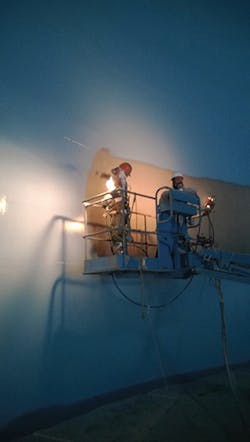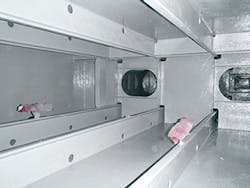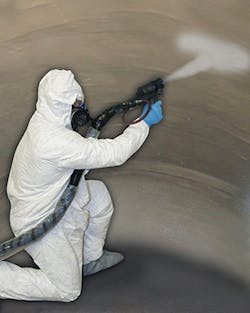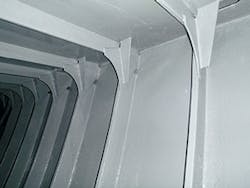With an eye to maintaining water quality in its potable water tanks, Huntsville Utilities in Alabama keeps all of its in-service tanks on a maintenance program that includes annual inspections.
“We go out every year and physically assess a percentage of the tanks so that we have 100% inspection on a five-year rotating basis,” says Jason Benson, a water engineer at Huntsville Utilities whose job entails overseeing the maintenance and rehabilitation of all of the water tanks.
Tank lining materials and application processes have become prime factors in increasing durability and ensuring water quality for US water utilities such as Huntsville’s.
Huntsville Utilities is a medium-sized utility providing service to 100,000 water customers through nearly 1,300 miles of water main. The utility has 38 welded steel water tanks in service; the oldest one dates to 1968.
The age of existing coatings is a major consideration in a Huntsville water tank lining rehabilitation project.
“We base it on the oldest in service as far as the interior coatings, although there are some exceptions to that,” notes Benson. “There was a time period in the early 1980s in which we went through some coatings in the industry that didn’t last as long as some of the coatings that came along later.”
Some of Huntsville’s tanks have a cathodic protection system and others don’t, “so we look at the interior part of the tank and its condition,” says Benson. “All things being equal, we might then start to look at aesthetics and the visibility of the tank. If we have two tanks that are in similar need as far as the internal coatings, we might select a tank for rehabilitation where the exterior is the worse of the two or maybe it’s in a more visible area.”
Huntsville Utilities operators conduct a complete rehabilitation of one tank per year.
“Then we might try to overcoat if we have tanks with some of the later systems,” says Benson. “In the 1990s, there were some really good high-build epoxy systems. Those tend to last pretty well, so on those tanks, we might do an assessment at 10 years and if it still looks good, we might do a wash repair and overcoat situation to extend the useful life of those coatings.”
Water quality concerns rank high in Huntsville Utilities’ water tank condition assessment process.
“As far as the materials we use in our rehab, we’ve got governing guidelines through the AWWA so we want to make sure we’re using industry-accepted products. But for us the real driving factor, because of the number of tanks we have in service, is that we try to find products that will let us extend that useful life as long as possible so we don’t have the tanks out of service any more often than is necessary,” says Benson.
To that end, Huntsville Utilities has used the Induron Protective Coatings’ PermaClean 100, a solvent-free, immersion grade, UL/NSF Standard 61 lining incorporating ceramic pigment into an amine-cured epoxy resin designed for maximum corrosion protection of immersed substrates. It is formulated for the protection of steel and concrete in potable water immersion service.
“It’s a green product and there’s no Volatile Organic Compounds [VOC] in it,” notes Henson. “It’s long-lasting, durable, and comes with a 15-year material warranty, which is important to us because of the number of tanks that we have to maintain.”
Henson’s advice to other water utility operators is to immerse themselves in education. His utility initially relied on consultants and sales representatives for information before Henson eventually trained to become a certified coatings inspector to better understand the materials as well as the processes involved with maintaining
steel tanks.
“That was invaluable to me because it lets me make a better informed decision without having to rely on outside influences,” he notes.
The PermaClean 100 product is one of seven NSF Standard 61 lining products for potable water offered by Induron, notes Davies Hood, company president.
The company’s focus is on protecting the substrate from the corrosive properties of potable water and the chlorine gas, he says.
PermaClean 100 is approved for up to 50 mils dry film thickness (DFT) applied by plural component equipment, notes Hood, adding that the paint lining is designed to operate as a single coat lining system.
Induron’s focus is on protecting the tank substrate from the corrosive properties of potable water and chlorine.
Another product offered by Induron is the TL70 Ceramic Epoxy, a two-component, high-build, high-solids, densely cross-linked, ceramic-modified epoxy.
TL 70 meets the requirements of AWWA D102-11 ICS-1 and complies with US EPA Ozone Transport Commission for VOC emission standards for industrial maintenance coatings.
The product has been certified for cold end-use by the Water Quality Association to meet the requirements of NSF/ANSI International Standard 61 for potable water immersion service in tanks 20,000 gallons and greater capacity. TL-70 is applied with conventional airless application equipment.
The ceramic pigments also reduce the permeability of the product and provide an antimicrobial surface, says Hood.
“They’re part of the paint film itself, so they inhibit microbial growth as long as the paint film is in place,” he adds. “The adhesion of the product is better than the cohesion of the paint to itself, so any pinholes or corrosion cells are almost self-capped and the paint doesn’t undercut.
“We developed the product line with some of the same pigment properties that had advantages of the ductile iron pipe lining we manufacture called Protecto401 and that’s a very corrosive atmosphere.”
There is a trend among potable water and wastewater utilities that are lining new tank structures even before they are commissioned, notes Rob Pearlman, senior containment systems engineer for AmTech Lining Systems.
Some concrete tank systems show oxidation and steel tanks show pitting corrosion. That can affect water quality, Pearlman notes.
In a project in which AmTech Lining Systems was recently involved, a concrete tank was undergoing spalling and getting to the point where it was exposing the iron rebar, which was rusting.
In a potable water system, that can affect water quality, allowing certain matter to leach out into the water, Pearlman points out. The same could hold true of a steel system that is chipping or peeling.
“That’s why lining is very important,” says Pearlman. “They’re having us come in when they build a plant before they even commission it and deal with a wastewater tank that’s never seen wastewater, or a potable water system that’s never seen potable water yet. The newest thing is them preparing to be ahead of the game.”
Pearlman notes the primary purpose of the systems that AmTech Lining Systems manufactures for water and wastewater is to preserve the physical plant to extend the service life of the equipment tanks, equipment, and containments used in the potable water industry and the wastewater industry.
One of the latest iterations of AmTech Tank Lining Systems’ DuraChem 580 systems is the DuraChem 580 PW, which is specifically formulated for potable water and is designed for service life improvements and adhesion capabilities in concrete and steel tanks, notes Pearlman.
In response to the changes in air temperature, sun heating, and wind deflection that can cause expansion, contraction, and movement of a tank structure, the DuraChem 580 PW is designed with flex and elongation characteristics.
Workers rehabilitate a water tank with Induron
Protective Coatings’ PermaClean 100.
It can perform as such without disbonding from its tank wall substrate, a significant factor that has caused failures, Pearlman points out.
The 580 PW is installed through a high-temperature, high-pressure spray-up application without VOC in the process. It is designed to cure within minutes and enable the tank to be put back into service with minimal downtime.
The resulting molecular bond and the mechanical tooth-and-suction bond are designed to provide up to 500 psi adhesion strength for the 80 to 125 mil monolithic shell.
As the functional service life of the coatings and linings of the nation’s wastewater tanks and containments reach the end, steel or concrete substrates can quickly corrode and degrade.
AmTech Tank Lining Systems’ DuraChem 580 Spray Up Polylining systems are designed to provide resistance to the liquids and gases found in wastewater streams in municipal and industrial wastewater treatment plants.
The system bonds inside the structure, separating the structural wall from the harsh environment of that wastewater stream and is designed to save thousands of dollars in capital replacement costs.
In lining a tank, the first step is substrate preparation. During that process, AmTech’s crews repair steel and concrete problems uncovered during the process. The company’s field engineering group performs non-destructive tests on tank structures with unknown conditions. Old linings can be inspected and tested. Ultrasonic tank wall thickness studies can be performed.
Chemco International offers a multipurpose tank and pipe lining system designed to be solvent-free and wet and rust tolerant for a variety of applications, including potable water and wastewater. It is NSF certified.
Ballast Tank after coating application
The lining features surface preparation flexibility and its application can be executed in any environmental condition, notes company spokesperson Ian Gold. There are no requirements for dehumidification or ventilation and no overcoating limitations. It is designed to be compatible with all shop primer and has no VOC.
Because the system is wet and rust tolerant, any surface preparation method can be utilized, including abrasive blasting, water jetting, or mechanical, notes Gold.
That’s a benefit for utilities seeking cost efficiencies, he adds.
“The most cost-effective and convenient method can be used, which can result in substantial time and cost savings being achieved,” says Gold. “The finish in this coating system is also very smooth, which can improve efficiency levels.”
Dependent on the specification given and achieved, the life expectancy of the lining can exceed 20 years, notes Gold.
Intertape Polymer Group (IPG) offers a wide range of geomembrane products for lining and directing water flow in retention ponds, canals, catch basins, ditches, and other water holding areas.
The Aquamaster geomembrane liner is utilized in water resource management, such as agricultural irrigation and water conservation.
NovaLiner is manufactured from a lightweight fabric and used for short-term applications. The heavyweight reinforced ArmorLiner geomembrane, with two heavy-woven HDPE fabrics is designed to be used for long-term and demanding applications.
Durachem 590 applied in chemical tank
Aquamaster-coated woven fabric geomembrane liners are constructed of polyolefin coatings, designed for optimal toughness and abrasion resistance.
The Aquamaster geomembrane liners are available in several widths and can be factory-fabricated and transported to the work site. Liners are available in medium- or heavy-weight fabrics with varying coating thicknesses and a selection of colors.
The Aquamaster geomembrane is recyclable, features minimal thermal expansion and contraction, and is designed to be extra strong to provide added resistance to tears and punctures. Engineered coatings provide hydrostatic resistance and heat seaming resistance. The membranes are also designed for UV resistance.
The IPG geomembrane is a polyethylene-based liner designed as one of the lighter materials on the market, made from resins that are lighter in composition, says Raphael Bennett, marketing manager for the company’s engineered coated products division.
That helps cut down on installation time, Bennett notes, adding that a crew of four to eight can do so without heavy machinery.
In its mission to preserve the economic and environmental health and well-being of California’s San Benito County through the control, management, and conservation of waters and the provision of water services in a practical and cost-effective manner, the San Benito County Water District takes a proactive approach to ensuring the quality of water throughout the area.
Part of this approach has entailed constructing a large pond to handle reclaimed water from surface water runoff. The pond is adjacent to the San Benito River bed. Most of the soils are a sandy gravel with trace amounts of silt and would not hold water.
Engineers from Dahl Consultants decided the pond needed to be lined to prevent the seepage of water outside of the pond. They sought a lining that would be durable and have a high puncture resistance, since the soils contained large amounts of rocks.
The liner also needed to have excellent strength properties for durability and the ability to hold up on the steepened slopes of the pond. Because the rocky soils would have a high likelihood of puncturing a liner, the engineers chose IPG Aquamaster ArmorLiner 45L for its strength-to-weight and puncture-resistance properties while confining and supporting water.
IPG Aquamaster ArmorLiner 45L was also chosen for its ability to be factory-fabricated into large panels, reducing both the installation time on the site and the need for additional field seams. The product was installed in one week during October 2016.
IPG tested multiple field cut samples of the material to ensure all properties on the site exceeded the specifications and standards of quality.
As for pipes leading into tanks, 3M offers its Scotchkote Pipe Renewal Liner 2400, which is designed to help protect water quality and service life in existing potable water pipes by inhibiting corrosion and tuberculation, maintaining internal pipe diameter, and repairing cracks, pin holes, and corrosion pitting.
The quick-curing polyurea formulation enables lined sections to be returned to service following 10 minutes of setting, 60 minutes of curing, and a 30-minute flush.
The trenchless solution is spray-applied using a spin cast method. It is designed as a cost-effective method for maintaining internal pipe diameters, increasing flow, improving efficiency, reducing water loss, and inhibiting corrosion and tuberculation.
It can be used in ductile, cast-iron, cement mortar-lined ductile, or cast iron or asbestos-cement drinking water mains between 4 and 36 inches in diameter.
Scotchkote Liner 2400 is NSF/ANSI-61 certified and approved for contact with drinking water in North America, among other countries. It is 100% solid and contains no VOCs or Bisphenol A and is applied by 3M-authorized applicators using certified application equipment for trenchless rehabilitation of potable water pipes.
Hood notes that the coatings industry continues to evolve.
“I’ve been in it 20 years and a lot of the product standards have changed over those last two decades because we keep making better products that not only provide better corrosion systems long-term, but also are more user-friendly,” he says. “That’s the trick in making effective linings for an elevated water tank. You’re 100 feet off the ground, the painter is in a confined space, hanging off of a rig applying the materials. It needs to be user-friendly, not something that is difficult to apply or require tricky equipment. We’re getting better and better at that.”
